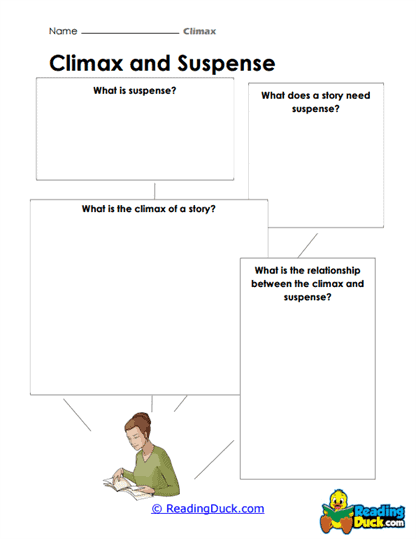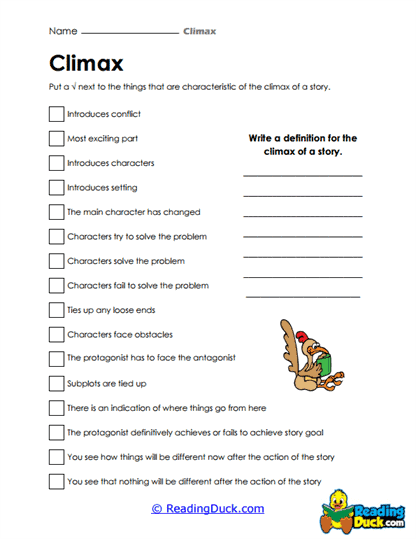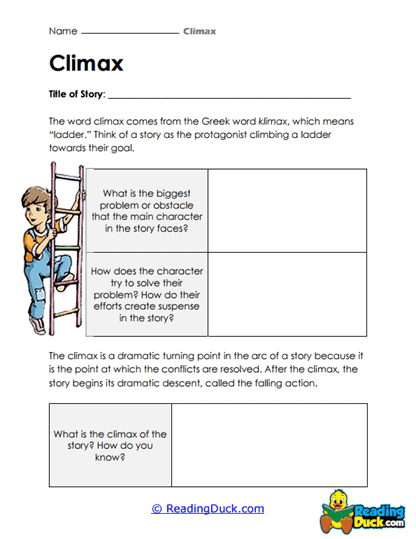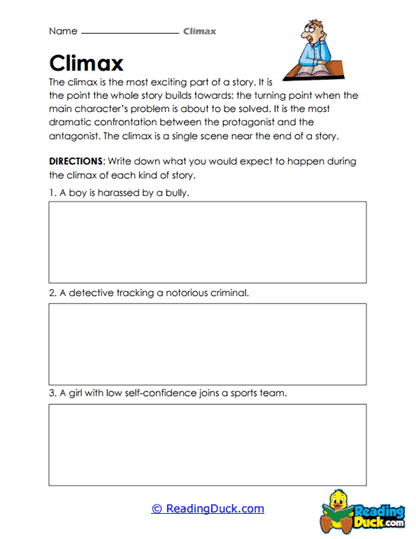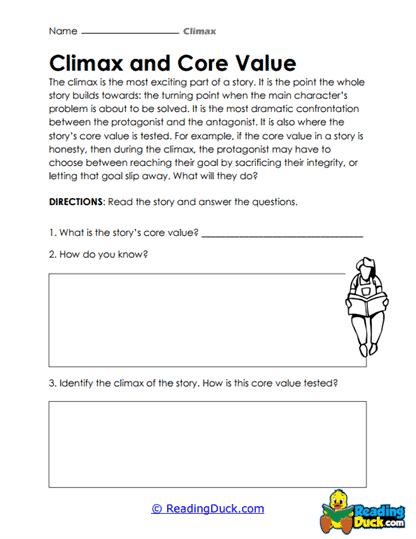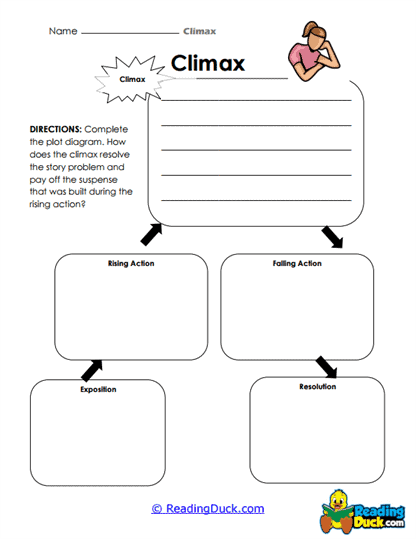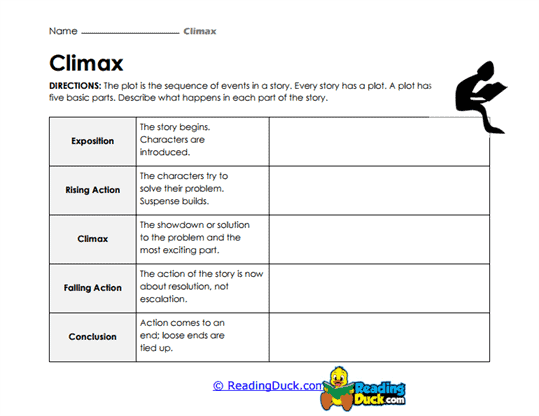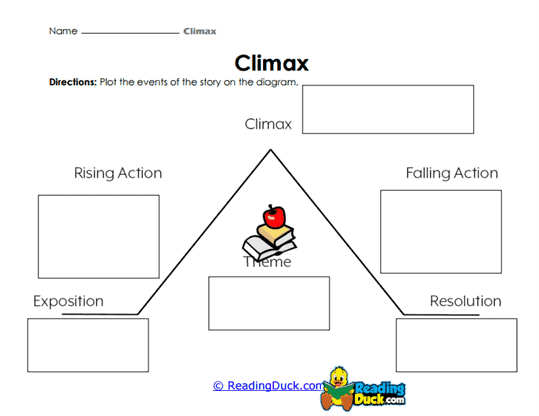Climax Worksheets
About Our Climax Worksheets
Our Climax Worksheets are a key resource within the Literary Devices category in the Skills section, designed to help students understand and master the concept of the climax in storytelling. The climax is a pivotal moment in any narrative, representing the turning point where the tension reaches its peak and the story's outcome becomes clear. These worksheets guide students through the identification, analysis, and creation of climactic moments, providing a structured approach to understanding this crucial literary device.
The worksheets are presented in PDF format, ensuring that they are easy to view, download, and print. This format is ideal for both classroom and home use, offering flexibility and convenience for educators and learners alike. Each worksheet includes a downloadable answer key, which supports accurate assessment and allows students to independently review and reinforce their understanding.
Understanding the Climax: A Comprehensive Exploration of Storytelling’s Turning Point
The climax is the most intense and decisive moment in a narrative, where the main conflict reaches its highest point and the outcome is set into motion. It is a critical component of storytelling, providing the emotional and narrative peak that shapes the resolution of the story.
What is the Climax?
- Definition: The climax is the point in a story where the main conflict reaches its peak, and the protagonist must face the greatest challenge. It is the moment when the tension that has been building throughout the story finally erupts, leading to a resolution. This turning point is often marked by a decisive action or revelation that determines the direction of the narrative.
- Example: In William Shakespeare’s Romeo and Juliet, the climax occurs when Romeo kills Tybalt. This act sets off a chain of events that leads to the tragic conclusion of the story. The intensity of this moment makes it the story's high point, where the consequences of the characters' actions become inevitable.
Elements of the Climax
- Peak of Emotional Intensity: The climax is characterized by the highest level of emotional engagement in the story. The stakes are at their highest, and the characters' emotions are fully engaged. For instance, in The Hunger Games by Suzanne Collins, the climax occurs when Katniss and Peeta are prepared to eat the poisonous berries, forcing the Capitol to declare them both winners. The tension and emotional intensity at this moment are palpable.
- Resolution of the Central Conflict: The climax typically involves the resolution or the beginning of the resolution of the central conflict. This is the moment when the protagonist either succeeds or fails in their primary goal, and the direction of the story is irrevocably changed. In Harry Potter and the Deathly Hallows, the climax is the final battle between Harry and Voldemort, where the fate of the wizarding world is decided.
- Irreversibility: Once the climax occurs, the events of the story cannot be undone. The choices made and actions taken during the climax set the course for the story’s conclusion. In To Kill a Mockingbird by Harper Lee, the climax is the trial of Tom Robinson, where the verdict seals the fates of the characters and underscores the themes of racial injustice.
- Character Development: The climax is also a crucial moment for character development. It often reveals the true nature of the characters, showing their growth or ultimate failings. In The Great Gatsby by F. Scott Fitzgerald, the climax occurs when Gatsby confronts Tom Buchanan about his relationship with Daisy. This moment reveals Gatsby’s idealism and Tom’s ruthlessness, leading to the unraveling of Gatsby’s dream.
The Climax in Literature: Historical Context and Importance
The concept of the climax has been central to storytelling since the earliest narratives, evolving alongside the development of literature to become one of the most important elements in any narrative structure.
Origins and Evolution of the Climax
The idea of the climax has roots in ancient storytelling traditions. In Greek drama, the climax was a critical part of the three-act structure, where it served as the pivotal moment in the plot. Aristotle’s Poetics, one of the earliest works on dramatic theory, discusses the importance of the climax as the turning point that leads to the resolution of the story. In classical tragedies, the climax was often a moment of profound realization or catastrophe, where the protagonist’s fate was sealed.
As literature evolved, the use of the climax became more nuanced, adapting to different genres and narrative forms. In the novels of the 19th century, the climax often involved a moral or social confrontation, reflecting the themes of the time. For example, in Charles Dickens’ A Tale of Two Cities, the climax occurs when Sydney Carton decides to sacrifice his life for the happiness of others, a moment that epitomizes the novel’s exploration of sacrifice and redemption.
In modern literature, the climax remains a crucial element, though it may take on more varied forms. Whether in the subtle emotional peak of a literary novel or the explosive confrontation in an action-packed thriller, the climax is the moment that gives a story its shape and direction. The evolution of the climax reflects the changing nature of storytelling, adapting to the expectations of different audiences and the demands of different genres.
The Role of the Climax in Developing Early Literacy Skills
Understanding the climax is vital for young learners as it plays a significant role in developing their literacy skills. Recognizing and analyzing the climax helps students become more engaged readers and more skilled writers.
- Enhanced Narrative Understanding: By learning about the climax, students gain a better understanding of narrative structure. They learn to identify the key moments in a story and understand how these moments contribute to the overall meaning of the narrative. This skill is crucial for reading comprehension and for analyzing texts in more depth.
- Improved Writing Skills: Studying the climax helps students improve their writing by teaching them how to build tension and structure their stories effectively. When students understand how to craft a powerful climax, they can create stories that are more compelling and satisfying for their readers.
- Critical Thinking and Analysis: Analyzing the climax of a story encourages students to think critically about the plot and the characters’ decisions. They learn to evaluate how different elements of the story come together at the climax, which enhances their analytical skills and deepens their understanding of literature.
- Emotional Engagement and Empathy: The climax often involves intense emotions, and understanding these moments helps students develop empathy for the characters. This emotional engagement makes reading more meaningful and helps students connect with the story on a deeper level.
Creative Ways to Reinforce Understanding of the Climax
To help students fully grasp the concept of the climax, educators can implement a variety of engaging and creative activities. These activities cater to different learning styles and grade levels, making the learning experience more dynamic and effective.
Suggested Activities
- Climax Identification Challenge (Grades 5-7): Have students read short stories or excerpts from novels and identify the climax. This activity helps them practice recognizing the turning point in different types of narratives.
- Write a Climax (Grades 6-8): Encourage students to write their own short story, focusing on crafting a strong climax. This exercise allows them to apply their understanding of how a climax should function within a narrative.
- Group Story Mapping (Grades 5-8): In groups, students can create story maps that outline the key events leading up to the climax of a story. This visual activity helps students see how the climax fits into the overall structure of the narrative.
- Analyze Famous Climaxes (Grades 7-9): Provide students with excerpts from well-known novels or films that feature memorable climaxes. Have them analyze why these moments are effective and how they contribute to the story’s resolution.
- Interactive Role-Play (Grades 6-8, Homeschool and Classroom): Students can act out scenes leading up to and including the climax of a story. This activity makes the concept of the climax more tangible and helps students understand the emotions and decisions involved.
The Practical Importance of Understanding the Climax
In conclusion, the Climax Worksheets are an essential tool for helping students understand one of the most critical elements of storytelling. Mastering the concept of the climax not only enhances students’ reading and writing skills but also deepens their appreciation of literature.
Understanding the climax is crucial for academic success, as it is a key component of literary analysis and comprehension. Being able to identify and analyze the climax allows students to engage with texts on a deeper level, making them more proficient readers and more thoughtful writers.
Beyond the classroom, the ability to recognize and appreciate the climax in stories enriches students’ personal lives by enhancing their enjoyment of literature, film, and other narrative forms. It also helps them develop critical thinking skills that are applicable in a wide range of contexts, from understanding complex narratives to making decisions in real-life situations.
Overall, mastering the concept of the climax equips students with valuable skills that will serve them well in both their academic and personal journeys, fostering a lifelong love of stories and an appreciation for the art of storytelling.
